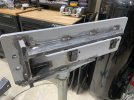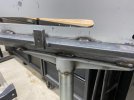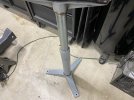Mach1 Driver
Well-Known Member
A variable DC drive for the bead roller.
Follow along with the video below to see how to install our site as a web app on your home screen.
Note: This feature may not be available in some browsers.
Hello there guest and Welcome to The #1 Classic Mustang forum!
To gain full access you must Register. Registration is free and it takes only a few moments to complete.
Already a member? Login here then!
And we have a correct answer!A variable DC drive for the bead roller.



Absolutely it is (and needs to be variable). If you're just running some long straight line and using a guide you can move along fairly quickly. If trying to follow a curve or doing something more intricate its better to be able to creep along. I built my motor control to be variable via a pot on the machine and the pedal simply switches the DC output to the motor via a 20 amp solid state relay (like you would use for the headlights in your car).Very nice, nothing like having to fully rebuild a new piece of equipment! Is the DC drive variable, or just and off and on with the foot pedal? I am not familiar with power driven bead rollers, so I don't know if variable speed would be a nice addition or not needed.
Would it not make sense to make it variable via the pedal, as to keep your hands free?Absolutely it is (and needs to be variable). If you're just running some long straight line and using a guide you can move along fairly quickly. If trying to follow a curve or doing something more intricate its better to be able to creep along. I built my motor control to be variable via a pot on the machine and the pedal simply switches the DC output to the motor via a 20 amp solid state relay (like you would use for the headlights in your car).
It wasn't a cheap project by any stretch but I ended up with a machine that is structurally as good or better than units priced at over $1000 (looking at you Eastwood) and capable of doing everything I should need. For about half the cost.
Not really. It's not like your TIG welding where you may need to raise and lower your power level depending on other variables as you go along. I suppose you could use it if you are making a turn then into a long straight run kind of situation but you're just forming metal. It doesn't care how fast you go. It's not a race. Better to approach it like a tortoise. Smooth and steady. The better you get at it the faster you might want to go but in my case it's not like I'm in production on parts to make and sell or anything.Would it not make sense to make it variable via the pedal, as to keep your hands free?
I guess there goes the idea of having you do all the hard work for my next build!Not really. It's not like your TIG welding where you may need to raise and lower your power level depending on other variables as you go along. I suppose you could use it if you are making a turn then into a long straight run kind of situation but you're just forming metal. It doesn't care how fast you go. It's not a race. Better to approach it like a tortoise. Smooth and steady. The better you get at it the faster you might want to go but in my case it's not like I'm in production on parts to make and sell or anything.
Didn't see that coming from youUhh, yes and yes.
Mark